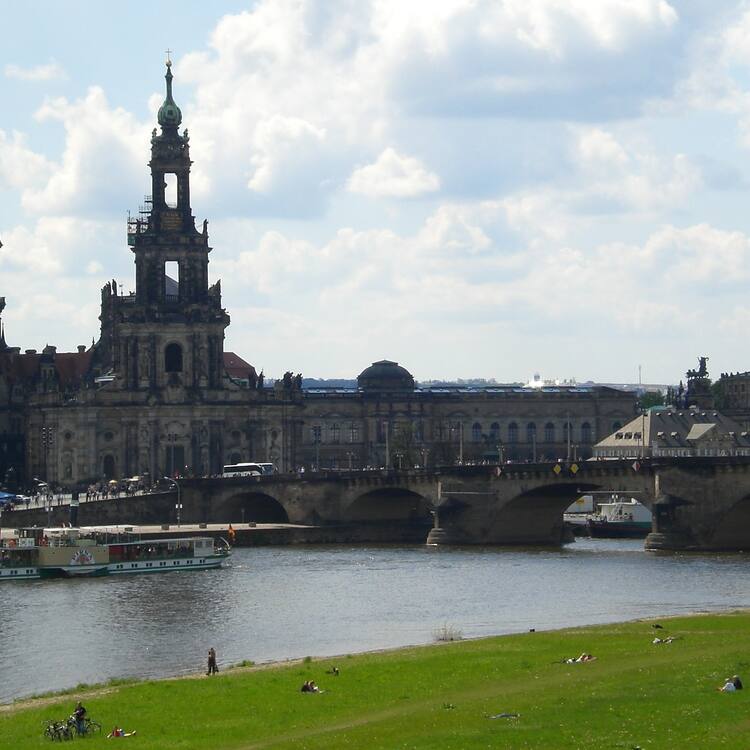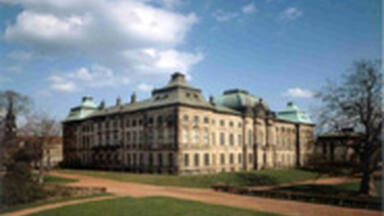Dresden Elbe Valley
Dresden Elbe Valley
The 18th- and 19th-century cultural landscape of Dresden Elbe Valley extends some 18 km along the river from Übigau Palace and Ostragehege fields in the north-west to the Pillnitz Palace and the Elbe River Island in the south-east. It features low meadows, and is crowned by the Pillnitz Palace and the centre of Dresden with its numerous monuments and parks from the 16th to 20th centuries. The landscape also features 19th- and 20th-century suburban villas and gardens and valuable natural features. Some terraced slopes along the river are still used for viticulture and some old villages have retained their historic structure and elements from the industrial revolution, notably the 147-m Blue Wonder steel bridge (1891–93), the single-rail suspension cable railway (1898–1901), and the funicular (1894–95). The passenger steamships (the oldest from 1879) and shipyard (c. 1900) are still in use.
Description is available under license CC-BY-SA IGO 3.0
Vallée de l’Elbe à Dresde
Le paysage culturel des XVIIIe et XIXe siècles de la vallée de l’Elbe à Dresde s’étend sur quelque 18 km le long du fleuve, du palais d’Übigau et des champs d’Ostragehege au nord-ouest jusqu’au château de Pillnitz et à l’île sur l’Elbe au sud-est. Ses prairies basses servent d’écrin au château de Pillnitz et au centre de Dresde, où abondent parcs et monuments surgis entre le XVIe et le XXe siècle. Le site comprend également des villas et des jardins des XIXe et XXe siècles. Les terrasses sur les coteaux sont toujours en partie consacrées à la viticulture, et certains villages anciens ont conservé leur structure d’époque, et des éléments datant de la révolution industrielle, notamment la « Merveille Bleue », un pont en acier de 147 m de long (1891-1893), le monorail funiculaire suspendu (1898-1901) et le funiculaire (1894-1895). Les bateaux à vapeur (le plus ancien remonte à 1879) et le chantier naval (vers 1900) sont toujours en activité.
Description is available under license CC-BY-SA IGO 3.0
وادي إلبة في دريسدن
يمتدّ المنظر الثقافي الذي يعود إلى القرنين الثامن عشر والتاسع عشر في وادي إلبة في دريسدن على حوالى 81 كلم على طول النهر وعلى طول قصر أوبيغو وحقول "أوستراجيهيج" في الشمال الغربي وصولاً إلى قصر بيلنتز والجزيرة التي تقع في جنوبلشرقي نهر إلبة. وتشكّل المراعي إطاراً طبيعياً لقصر بيلنتز ووسط دريسدن حيث تكثر الحدائق والنصب التي شيّدت بين القرنين السادس عشر والقرن العشرين. ويشمل الموقع أيضاً بيوتا وحدائق أنشئت في القرن التاسع عشر والقرن العشرين. ولا تزال الجلول على السفوح مخصصة في غالبيتها لزراعة العنب وقد حافظت بعض القرى القديمة على بنيتها القديمة وعلى عناصر تعود إلى الثورة الصناعية، ولا سيما منها "الروعة الزرقاء" وهو جسر من معدن طوله 741 متراً (1898- 1901) والقطار الجبلي المعلق ذو سكة وحيدة (1898-1901) والقطار الجبلي العادي (1894-1895). أما البواخر البخارية والأقدم بينها يعود إلى (1879) ومصنع السفن (حوالى1900)، فلا تزال كلها تعمل.
source: UNESCO/CPE
Description is available under license CC-BY-SA IGO 3.0
德累斯顿的埃尔伯峡谷
18世纪和19世纪的德累斯顿的埃尔伯峡谷景观起始于西北部的于毕高宫(Übigau Palace)和奥斯特拉葛黑葛平原(Ostragehege fields),东南一直延伸到皮尔尼茨宫(Pillnitz Palace)和易北岛(Elbe River Island),沿着河谷纵深有18公里长。这里主要有低洼草地,顶部的皮尔尼茨宫,遗迹德累斯顿中心,还有16至20世纪的无数古迹和公园,同时这里还拥有19世纪和20世纪的郊区别墅、花园以及极具价值的自然风光。今天,一些沿河梯田仍然种植着葡萄,一些古老的村庄仍然保留着工业革命时期的历史建筑和设施,特别是长147米的钢桥(1891年至1893年)、单轨吊索铁路(1898年至1901年)和索道(1894年至1895年)。古老的汽船(起源于1879年)和成立于1900年的造船厂至今仍在使用。
source: UNESCO/CPE
Description is available under license CC-BY-SA IGO 3.0
Долина Эльбы у Дрездена
Культурный ландшафт долины Эльбы близ Дрездена, сформированный в XVIII-XIX вв., имеет протяженность примерно 18 км – от дворца Юбигау и полей Острагехеге на северо-западе до дворца Пильниц и острова на Эльбе на юго-востоке. Его компонентами являются пойменные луга, пригородные виллы XIX-XX вв. и сады, а «увенчан» он дворцом Пильниц и центром города Дрезден, с его многочисленными памятниками и парками, относящимися к XVI-XX вв. Некоторые террасированные склоны вдоль реки все еще используются для виноградарства, а отдельные поселки сохранили свою историческую структуру и фрагменты застройки эпохи промышленной революции.
source: UNESCO/CPE
Description is available under license CC-BY-SA IGO 3.0
Valle del Elba en Dresde
El paisaje cultural del Valle del Elba en Dresde, creado durante de los siglos XVIII y XIX, se extiende por las orillas de este río a lo largo de 18 kilómetros con un eje de orientación noroeste–sudeste, desde el Palacio de Übigau y las praderas de Ostragehege hasta el Palacio de Pillnitz y la isla del Elba. En este espectacular paisaje formado por praderas bajas, destacan el palacio de Pillnitz y el centro histórico de la ciudad con sus numerosos monumentos y parques que datan de los siglos XVI al XX. En las laderas del valle se sigue cultivando la viña en bancales. Algunos pueblos antiguos de los alrededores han conservado su estructura ancestral, así como vestigios de la Revolución Industrial, entre los que destacan la “Maravilla Azul”, un puente de acero de 147 metros de longitud, construido entre 1891 y 1893, así como un monorriel suspendido (1898-1901) y un funicular (1894-1895). Los barcos de vapor (el más antiguo data de 1879) y el astillero (construido hacia 1900) están aún en funcionamiento.
source: UNESCO/CPE
Description is available under license CC-BY-SA IGO 3.0
ドレスデン・エルベ渓谷
source: NFUAJ
Justification for Inscription
Criterion (ii): The Dresden Elbe Valley has been the crossroads in Europe, in culture, science and technology. Its art collections, architecture, gardens, and landscape features have been an important reference for Central European developments in the 18th and 19th centuries.
Criterion (iii): The Dresden Elbe Valley contains exceptional testimonies of court architecture and festivities, as well as renowned examples of middle-class architecture and industrial heritage representing European urban development into the modern industrial era.
Criterion (iv): The Dresden Elbe Valley is an outstanding cultural landscape, an ensemble that integrates the celebrated baroque setting and suburban garden city into an artistic whole within the river valley.
Criterion (v): The Dresden Elbe Valley is an outstanding example of land use, representing an exceptional development of a major Central-European city. The value of this cultural landscape has long been recognized, but it is now under new pressures for change.



